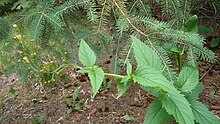Scrophularia lanceolata is a species of flowering plant in the figwort family known by the common names lanceleaf figwort and American figwort.[4] It is native to North America, where it is known from western and eastern Canada and much of the United States except for the southeastern quadrant.[5] Past common names include Western figwort when the western US plants were grouped under the name Scrophularia occidentalis and the eastern US plants were called Scrophularia leporella with the common name hare figwort.[6]
| Scrophularia lanceolata | |
|---|---|

| |
| Scientific classification | |
| Kingdom: | Plantae |
| Clade: | Tracheophytes |
| Clade: | Angiosperms |
| Clade: | Eudicots |
| Clade: | Asterids |
| Order: | Lamiales |
| Family: | Scrophulariaceae |
| Genus: | Scrophularia |
| Species: | S. lanceolata
|
| Binomial name | |
| Scrophularia lanceolata | |
| Synonyms[1][2][3] | |
|
List
| |
Description and habitat
editScrophularia lanceolata is a perennial herb producing clusters of erect or spreading stems up to 1.5 meters long. The oppositely arranged leaves have toothed, triangular or lance-shaped blades up to 14 centimetres (5.5 in) long which are borne on short petioles. The inflorescence is a wide-open panicle with several hairy, glandular branches bearing flowers. The flower has a spherical or urn-shaped corolla opening at the top into a narrow mouth edged with hoodlike lobes. The corolla is roughly 1–1.5 centimetres (0.39–0.59 in) long and is greenish tinged with brown or dull pink. The wide staminode is generally visible in the mouth of the corolla. The ripe fruit is a brown, teardrop-shaped capsule just under a centimeter long, containing many very small black seeds which are released when the capsule splits in half.[7]
It grows part shade to full sun; Scrophularia lanceolata is found in open woods, thickets, along roadsides, and railroad rightaways, and in open fields.[7]
The plant has been used medicinally to treat swollen glands.[8]
References
edit- ^ "Scrophularia lanceolata Pursh". www.worldfloraonline.org. Retrieved 2021-01-21.
- ^ "Scrophularia occidentalis (Rydb.) E.P.Bicknell". www.gbif.org. Retrieved 2021-01-21.
- ^ "Scrophularia leporella E.P.Bicknell". www.gbif.org. Retrieved 2021-01-21.
- ^ "Scrophularia lanceolata Pursh". www.gbif.org. Retrieved 2021-01-21.
- ^ "Lanceleaf figwort". USDA. Plants Profile. Retrieved July 10, 2010.
- ^ Gentianaceae to Compositae; gentian to thistle. Dover Publications; 1970. ISBN 978-0-486-22644-6. p. 180.
- ^ a b "Scrophularia lanceolata (Lance-leaf Figwort): Minnesota Wildflowers". www.minnesotawildflowers.info. Retrieved 2021-01-21.
- ^ Fagan, Damian (2019). Wildflowers of Oregon: A Field Guide to Over 400 Wildflowers, Trees, and Shrubs of the Coast, Cascades, and High Desert. Guilford, CT: FalconGuides. p. 153. ISBN 978-1-4930-3633-2. OCLC 1073035766.
External links
edit